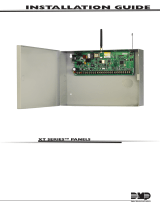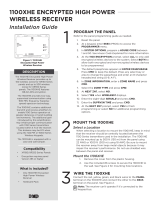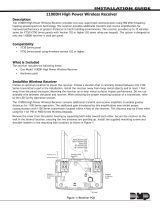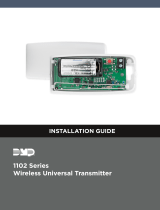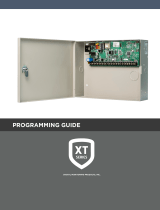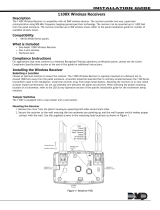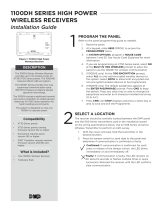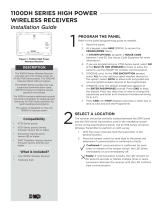Page is loading ...

InstallatIon GuIde
1100D Wireless Receiver
Description
The 1100D Wireless Receiver provides up to 32 wireless zones for XT30/XT50 Series Version 102 or higher. The 1100D
provides two-way, supervised communication using 900 MHz frequency hopping-spread-spectrum technology. The
receiver can be mounted up to 500 feet from the panel enclosure.
Compatibility
XT30 Series panel•
XT50Seriespanelusingrmwareversion102orhigher•
What is Included
The 1100D Wireless Receiver includes the following items:
One Model 1100D Wireless Receiver•
One 4-wire Harness•
Hardware pack •
Installing the Wireless Receiver
Selecting a Location
Choose an optimum location to mount the receiver. The 1100D Wireless Receiver is typically mounted at a distance
not to exceed 500 feet away from the panel enclosure. A location should be selected that will be centrally located
between the 1100 Series transmitters used in the installation. Install the receiver away from large metal objects.
Mounting the receiver on or near metal surfaces impairs performance. Do not used shielded wire between the panel
and receiver. When selecting the proper mounting location and operation, refer to the LED Survey Operation section
ofthespecicinstallationguideforthetransmitterbeinginstalled.
Mounting the Receiver
1. Remove the cover from the plastic housing by squeezing both sides toward each other.
2. Secure the receiver to the wall in the desired location installing the supplied shoulder washers and screws in
the mounting hole locations as shown in Figure 1.
3. Snap the cover back on the unit. The panel immediately recognizes the 1100D Receiver if the panel is
programmed with a house code.
Panel Receive
Panel Transmit
Status
RF Receive
RF Transmit
LEDs
U5
1
J5
1
RED
J4
1
PROG
PANEL
J3
1
RED
Power
RXD
TXD
Status
RF RXD
RF TXD
U8
1
J4
1
U4
1
Q2
U7
J1
1
Mounting Hole
Locations
Squeeze to
Remove Cover
Squeeze to
Remove Cover
J4 Not Used
J3 Connects
To Panel
Mounting Screw
Shoulder Washer
Figure 1: Receiver PCB

Digital Monitoring Products 1100D Wireless Receiver Installation Guide
2
Keypad Bus Wiring
The 1100D Wireless Receiver easily interfaces with the XT30/XT50 Series panels using the keypad bus.
Harness Connection
Refer to Figure 2, the XT30/XT50 Series Programming Guide (LT-0981) and use the following steps to connect the
panel and receiver:
1. Using the supplied 4-wire harness, connect from the 1100D Wireless Receiver J3 header to the panel keypad
bus terminals 7, 8, 9, and 10. Observe wire colors when connecting to the terminals.
2. In System Options, program the House Code (1-50). In Zone Information, program the wireless zones.
U5
1
J5
1
RED
J4
1
PROG
PANEL
J3
1
RED
Power
RXD
TXD
Status
RF RXD
RF TXD
U8
1
J4
1
U4
1
U7
J1
1
Black
Green
Yellow
Red
J4
RED
PRO
J8
XT30/XT50 Series Panel
J7
RJ SUP
AC
1
2
3
456 7
8
10
11 12
9
+B
BELL
GND
SMK
RED
YEL
GRN
BLKAC
-B
1100D
Receiver
J4 Not Used
Can be extended
up to 500 feet
from the panel
Figure 2: XT30/XT50 Series Keypad Bus Wiring
1100D Receiver Operation
The 1100D receiver automatically sends the panel house code to wireless transmitters when the unique transmitter
serialnumberisprogrammedintothepanel.Thehousecodeidentiesthepanel,receiver,andtransmitterstoeach
other.Thereceiveronlylistensfortransmissionsusingthespeciedhousecodeand/orprogrammedtransmitter
serial number.
Note: When setting up a wireless system, it is recommended to program zones and connect the receiver before
installing batteries in the transmitters.
Transmitters can be programmed for supervised or unsupervised operation. When programmed as supervised, the
transmitter must communicate with the receiver within the programmed number of minutes. If the transmitter fails
to communicate, the panel displays a missing condition.
Note: When a receiver is installed, powered up, or the panel is reset, the supervision time for transmitters is reset.
If the receiver has been powered down for more than one hour, wireless transmitters may take up to an additional
hour to send a supervision message unless tripped, tampered, or powered up. This operation extends battery life for
transmitters. A missing message may display on the keypad until the transmitter sends a supervision message.
When any wireless zone programming is changed in the panel, receiver zone programming is updated when exiting
panel programming. During the update, all wireless zones display as normal for approximately one minute,
regardless of the actual state of the wireless device(s).
LED Operation
Six LEDs display receiver operation and activity. Refer to the table below as required.
PCB LEDs Label Operation
Power
RXD
TXD
Status
RF RXD
RF TXD
POWER Steady green to indicate there is power to the receiver.
RXD Flashes yellow to indicate data is being received from the panel.
TXD Flashes green to indicate data is being sent to the panel.
STATUS
Steady red to indicate memory upload. Off when upload is complete.
RF RXD Flashes yellow to indicate data is being received from a transmitter.
RF TXD Flashes green to indicate data is being sent to a transmitter.

1100D Wireless Receiver Installation Guide Digital Monitoring Products
3
Zone Conguration
Refer to the XT30/XT50 Series Programming Guide (LT-0981) for complete wireless programming information.
Note: When any wireless input zone for a particular address is programmed (Ex: 11-14 = Addr 1), the 1100D responds
to the panel for this address. Other devices, such as keypads or hardwired zone expanders, cannot use this address.
Zones connected directly to the panel cannot be wireless.
Keypad Address Zone Numbers
XT30/XT50 Series
1 11-14
2 21-24
3 31-34
4 41-44
5 51-54
6 61-64
7 71-74
8 81-84
Transmitter Survey LED Operation
DMP 1100 Series transmitters provide Two-way (transmit acknowledge) operation. This advanced data protocol
allowseachtransmittertoconrmthateachofitsmessages(alarm,checkin,tamper,lowbattery)arereceived
andacknowledgedbythe1100Seriesreceiver.TheconrmationisindicatedvisuallybyuseofanLEDoneach
transmitter. This Survey LED should be used during installation to test each transmitter for proper operation. A full
denitionoftheSurveyLEDfollows.
The red LED on an 1100 Series transmitter turns on when the processor wakes up to send a message. Then after a
series of communication steps are completed (successful or not), the LED turns off when the processor goes back
to sleep. 99.9% of the time the processor is asleep in normal operation. The following list summarizes various
indicationsthatcanbeobservedontheLEDandadenitionforeach.Notethisisforasinglemessage.Example,
pressing and holding the tamper switch.
Single 1/16 second ash
•Processorwakesup
•Transmitterreceivesimmediatesynchronizationfromreceiver
•Transmittertransmits
•Transmitterreceivesimmediateacknowledgementfromreceiver
•Processorgoestosleep
Single Pulse greater than 1/16 second but shorter than 8 seconds
•Processorwakesup
•Transmitterreceivessynchronizationfromreceiver-possiblynotimmediate
•Transmittertransmits
•Transmitterreceivesacknowledgementfromreceiver-possiblynotimmediate
•Processorgoestosleep
Steady for 8 seconds
•Processorwakesup
•Transmitterneverreceivessynchronizationfromreceiver,ormightreceivesynchronization
•Transmittertransmitsifsynchronizationwasreceived
•Transmitterneverreceivesanyfurtherdatafromreceiver
•Processortimesoutandgoestosleep
Multiple short ashes
•Processorwakesup
•Transmitterreceivessynchronizationfromreceiver
•Transmittertransmits
•Transmitterreceivesdatafromreceiver,butnotavalidacknowledgement
•Processorbrieygoestosleep
•Entiresequenceisrepeated,eachshortashindicatesacycle

Digital Monitoring Products 1100D Wireless Receiver Installation Guide
4
Troubleshooting Using the Transmitter Survey LED
If a transmitter is unable to reliably communicate a message to the receiver, or is reported as missing, the Survey
LED can be used to help diagnose the issue. If the missing transmitter cannot be explained by obvious reasons such
as a damaged transmitter, failed battery, or changes in building construction; then the Survey LED should be used.
TousetheSurveyLEDoperationtohelpdiagnoseaeldissue,completethefollowingstepsonan1100Series
transmitter. Repeat the following sequence 5 times and write down the LED operation for each tamper switch
action.
•Pressandholdthetamperswitch
•ObservetheLEDuntilisturnsoffforatleast5seconds
•Releasethetamperswitch
•ObservetheLEDuntilisturnsoffforatleast5seconds
You now have observed the LED 10 times. Based on the results you have recorded use the list below to assist in
troubleshooting.
LED turns on a single time for less than 1 second 8 to 10 times.
•Systemisworkingproperly
LED turns on for more than 1 second 3 to 9 times.
•Thetransmitterorreceiverneedstoberelocated
LED turns on for more than 1 second all 10 times.
•Thereceiverisnotturnedon,orisnotoperating
•Thetransmitterisnotprogrammedintothereceiver
•Thetransmitterorreceiverneedstoberelocated
LED ashes multiple times with a single tamper press or release 3 to 10 times.
•Thetransmitterorreceiverneedstoberelocated
LED never turns on.
•Thetransmitterbatteryisdead
•Thetamperswitchisbeingpressedorreleasedtooquickly
•Thetamperswitchorotherpartofthetransmitterisbroken
LED stays on constantly and is dim
•Thetransmitterbatteryisalmostdead
•Thetransmitterisbroken
General Wireless Troubleshooting
If ALL wireless devices do not operate, refer to the following checklist:
• Verifyequipmentmodelnumbers.
• VerifytheHouseCode(1-50)isprogrammedinSystemOptions.
• Verifythe4-wireconnectorfromthereceiverJ3isconnectedtotheXT30/XT50panelterminals7,8,9,and
10.
• Verifywhatzonenumbersareassignedaswirelesszonesandchecktheaddresssettingsofotherdevice(s)
connected to the keypad bus to ensure no duplicate addresses have been used.
• Verifythe1100DLEDsareoperatingaslistedin1100DLEDOperationonthepreviouspage.
• Verifytransmittershavebatteriescorrectlyinserted.

1100D Wireless Receiver Installation Guide Digital Monitoring Products
5
Transmitter Supervision Time
For UL Listed installations, program the transmitter supervision time in panel zone programming as listed in the
following table. Refer to the XT30/XT50 Series Programming Guide (LT-0981) for complete wireless programming
information.
UL Listing Listed Accessories
Supervision
Time
UL 1023 Household Burglary Alarm System Units Accessory 1100R Repeater
1101/1102/1103/1105 Universal Transmitters
1125/1127W/1127C PIR Motion Detector
1135 Siren
1142 Two-Button Hold-Up Transmitter
9060/9063 Keypads
60
UL 636 Holdup Alarm Units and Systems Accessory 1142 Two-Button Hold-Up Transmitter 60
UL 634 Connections and Switches for use with Burglar Alarm
Systems Accessory
1100R Repeater
1101/1102/1103/1105 Universal Transmitters
60
UL 639 Intrusion Detection Units Accessory 1100R Repeater
1125/1127W/1127C PIR Motion Detector
60
UL 365 Police Station Connected Burglar Accessory 1100R Repeater
1103 Universal Transmitter
60
UL 609 Local Burglar Alarm Units and System Accessory 1100R Repeater
1103 Universal Transmitter
60
UL 1076 Proprietary Burglar Alarm Units Accessory 1100R Repeater
1103 Universal Transmitter
60
UL 1610 Central Station Burglar Alarm Units Accessory 1100R Repeater
1103 Universal Transmitter
1135 Siren
9060/9063 Keypads
60
UL 268 Smoke-Automatic Fire Detectors 1100R Repeater
1161/1162 Residential Smoke Detectors
3
UL 985 Household Fire Warning System Accessory 1100R Repeater
1101/1102/1105 Universal Transmitter
1135 Siren
9060/9063 Keypads
240
FCC Information
This device complies with Part 15 of the FCC Rules. Operation is subject to the following two conditions:
(1) This device may not cause harmful interference, and
(2) this device must accept any interference received, including interference that may cause undesired operation.
Changesormodicationsmadebytheuserandnotexpresslyapprovedbythepartyresponsibleforcompliancecouldvoidthe
user’s authority to operate the equipment.
Note: This equipment has been tested and found to comply with the limits for a Class B digital device, pursuant to part 15 of
the FCC Rules. These limits are designed to provide reasonable protection against harmful interference in a residential
installation. This equipment generates, uses and can radiate radio frequency energy and, if not installed and used
in accordance with the instructions, may cause harmful interference to radio communications. However, there is no
guarantee that interference will not occur in a particular installation. If this equipment does cause harmful interference to
radio or television reception, which can be determined by turning the equipment off and on, the user is encouraged to try
to correct the interference by one or more of the following measures:
- Reorient or relocate the receiving antenna.
- Increase the separation between the equipment and receiver.
- Connect the equipment into an outlet on a circuit different from that to which the receiver is connected.
- Consult the dealer or an experienced radio/TV technician for help.
Note: The 1100 Series wireless system is a two-way supervised wireless design. It is compliant with FCC rules as they pertain to 900
MHz Spread Spectrum devices. In rare instances it has been observed that certain 900 MHz cordless telephones may occasionally
experience a clicking sound on the telephone while in use. If this occurs, it may be resolved by selecting a different channel on the
cordless telephone, or replacing the cordless phone with a different brand or model of 900 MHz telephone or other cordless telephone.
To comply with RF exposure requirements, a minimum distance of 20cm must be maintained between the antenna and all persons.

LT-0692 1.04 © 2010 Digital Monitoring Products, Inc.
800-641-4282
www.dmp.com
Made in the USA
INTRUSION•FIRE•ACCESS•NETWORKS
2500NorthPartnershipBoulevard
Springfield, Missouri 65803-8877
10445
Attention! Older Cordless Telephones
Your wireless alarm system is comprised of a state-of-the-art two-way secure network created by sophisticated transmitters and
receivers. It is compliant with all FCC rules as they pertain to 900 MHz Spread Spectrum devices which require devices to share
the same frequencies. This creates a possibility of interference with other devices in your home.
It has been reported that certain older 900 MHz cordless telephones may on rare occasions experience interference (an
audible clicking sound) while in use. (This may also occur with some 2.4 GHz and 5.8 GHz telephones as many still use 900 MHz
frequencies). If this occurs on your cordless telephone, it may be resolved by selecting a different channel on your telephone.
If your telephone does not have this selection, it can also be resolved by replacing your old cordless telephone with a DECT 6.0
cordless telephone.
What is DECT 6.0?
DECT 6.0 (Digital Enhanced Cordless Telecommunications) is the current standard for cordless telephones, and it provides several
benetsover900MHz,2.4GHzand5.8GHzsystems.
NoMoreInterference-unlikeoldercordlesstechnology,DECT6.0telephonesarevirtuallyimmunetohouseholdinterference,•
and vice versa. If you have a wireless computer network in your home, DECT 6.0 won’t disrupt your internet use.
Encrypted Privacy – DECT 6.0 has a layer of security that older cordless telephones just don’t have. As information and •
identity theft is on the rise, DECT encryption helps keep your personal communications safe.
CallQuality-Extrasecurityisn’tjustforsafety;itgivesyouclearercallswithoutcrossovertrafc.•
Battery Life - A DECT 6.0 phone will last as much as 30% longer than a 5.8 GHz phone.•
More information can be found on DECT technology at www.DECT.org.
DECT 6.0 Cordless phones can be found at any major retailer including: Wal-Mart™, Target™, Best Buy™ & Radio Shack™.
Specications
Operating Voltage 8.0 to 14 VDC
Current Draw 40mA
Frequency Range 903-927 MHz
Dimensions
Receiver Housing 4.65” L x 3.1” W x 1.4” H
Antennas 8.6” H
Color White
Housing Material Flame retardant ABS
Patents
U.S.PatentNo.7,239,236
Listings and Approvals
California State Fire Marshal (CSFM)
FCC Part 15 Registration ID CCK1100
IC Registration ID 5251A-PC0082
Underwriters Laboratories (UL) Listed
ANSI/UL365 PoliceStationConnectedBurglar
ANSI/UL609 LocalBurglarAlarmUnitsandSystems
ANSI/UL634 ConnectionsandSwitchesforusewith
Burglar Alarm Systems Accessory
ANSI/UL636 HoldupAlarmUnitsandSystem
ANSI/UL639 IntrusionDetectionUnitsAccessory
ANSI/UL1023 HouseholdBurglarAlarmSystemUnits
ANSI/UL1076 ProprietaryBurglarAlarmUnits
ANSI/UL1610 CentralStationBurglarAlarmUnits
ANSI/UL268 Smoke-AutomaticFireDetectors
ANSI/UL985 HouseholdFireWarningSystem
/



